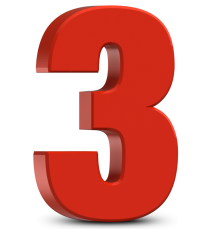 Last fall I kicked off a series of math-y posts with On the Count of Three, some thoughts about the groupings of three that occur around us, both naturally and in things we create. The idea of triplets is an obvious progression from the idea of binary opposition — quintessentially expressed in the metaphor of Yin and Yang.
Last fall I kicked off a series of math-y posts with On the Count of Three, some thoughts about the groupings of three that occur around us, both naturally and in things we create. The idea of triplets is an obvious progression from the idea of binary opposition — quintessentially expressed in the metaphor of Yin and Yang.
Ever since that post, I’ve been noticing (and then noting) various instances of triplets. It really is a fundamental way reality expresses itself. (And more than just metaphorically — matter literally has three-ness!)
Here are some of the other triples I’ve noted…
A key aspect of Yin-Yang is the tension between the poles, especially when the poles are balanced rather than being “cup” pairs (where one pole is something and the other pole is the absence of that thing).
That tension tends to be absent with triplets, although in bi-polar mode, there can be tension between the two extremes as well as between the center and the extremes. Usually there’s a Yin-Yang, along with a center marker, underlying the mode, and the tension is more from that.
For instance:
- high — (middle) — low
- big — (medium) — small
- left — (center) — right
- forward — (still) — backward
- for — (neutral) — against
- yes — (maybe/unknown) — no
These can all be case as Yin-Yang (balanced) pairs, but as triples we elevate the center as having the same metaphorical weight as the poles. And, for example, big–medium–small is a different metaphor than big–small.
With regard to our stories, I mentioned The Trilogy and the general rule of three writers often use when listing things (like lions, tigers, and bears).
Storytelling has many other triples:
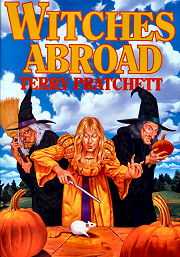 Traditionally, a witch coven has three members: Maiden, Mother, Crone.
Traditionally, a witch coven has three members: Maiden, Mother, Crone.
(In Terry Pratchett’s Discworld Witches books, the head witch, Granny Weatherwax, is quite testy about that last label. The other two witches have learned, under Granny’s glares, to say: “Maiden, Mother, and … the other one.”)
And speaking of witches, there is the well-known Rule of Three, which says that whatever energy you put into the world is returned three times over. There may be some tie to how triples show up in a lot of spiritual contexts.
Or, for that matter: Animal, Mineral, or Vegetable?
Something I’ve observed for a very long time is that storytellers have three options when it comes to telling stories involving the supernatural (ghosts, angels, Santa Claus, and so forth).
Those options boil down to: Yes (it’s real), No (it’s not), or Maybe (I’m not saying; you decide).
The delightful old TV series Night Court makes an interesting case study (in part because this was one place where I really began noticing these choices).
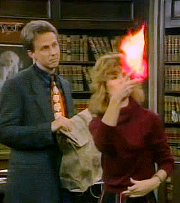 At first the writers went with: “Maybe!” Various apparently supernatural things that happened in Harry’s courtroom (and life), but neither we nor the characters ever knew for sure it all didn’t have a natural explanation (including being actively tricked).
At first the writers went with: “Maybe!” Various apparently supernatural things that happened in Harry’s courtroom (and life), but neither we nor the characters ever knew for sure it all didn’t have a natural explanation (including being actively tricked).
But later in the series they began to go with: “Yes!” Harry got involved with a real witch, and Santa Claus really did appear in his courtroom.
The “No” option is reflected in Sherlock Holmes as well as in the Scooby Doo cartoons (it’s always a trick). Contrast this with the early Night Court, which left the matter open — no natural explanation is ever discovered to resolve the matter.
This triplet is very similar to: Theist (yes, it’s real), Atheist (no, it’s not), or Agnostic (I’m not saying (because I don’t know); you decide). It boils down to Yes–Maybe/Unknown–No.
§
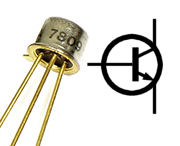 In the world of electronic hardware, last time I mentioned bi-polar power supplies and signaling systems.
In the world of electronic hardware, last time I mentioned bi-polar power supplies and signaling systems.
That just scratches the surface. With both vacuum tubes (“valves”) and transistors, an amplifier circuit basically has three electrical connections: Input, Output, and Common (think of that last one as a “tether” keeping the circuit in place).
The reality does involve more connections (at least with tubes), but fundamentally, any amplifier has those crucial three. (And transistors do have only three leads.)
In the software world, a very common top-down way of decomposing a problem and building a system to solve it is called IPO — Input, Processing, Output.
 You start with a box labeled: “The System” (or whatever you’ve named your system).
You start with a box labeled: “The System” (or whatever you’ve named your system).
Coming from that are three boxes with lines connecting them to the first box (like a hierarchy chart).
The first new box is the input(s) to your system, the next one is the output(s), and the last one is the processing.
You repeat this process, breaking each box down into the IPO for that part until you’re down to a level where the boxes become obvious modules you can write.
It turns out that many software problems resolve to Input, Processing, and Output. (Not all, so it’s not a universal technique, but it’s a pretty good one. There are others that fit as: Initialization, Processing, and Clean-up. Or, with files and other resources: Open, Use, and Close.)
§
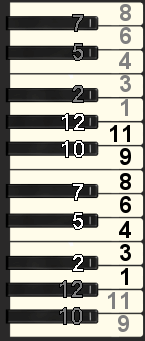
A, A?, B, C, C?…
Lastly, the world of music has a number of interesting triples.
Firstly, there are note triples, a series of three notes played against a time signature that expects two.
And, of course, there is music written with a three-beat time signature. Waltzes are famous for it (one-two-three, one-two-three). The Christmas carol, Silent Night, is written with a time signature of six beats.
Digging deeper, we find three-ness in basic music theory. For now, I’ll only touch on this. I plan to get more into it some other post.
The Western music scale has twelve notes, which is 2×2×3, so there is both two-ness and three-ness already (double two-ness, even). These notes are repeated over and over in musical octaves (where the notes have double or half the pitch of the ones below or above, respectively).
A musical key (for instance, the key of C) has seven notes (also repeated over and over). Many, many melodies are comprised of only the seven notes within the key (rather than all twelve). When this is true, the melody can be arranged with only three chords.
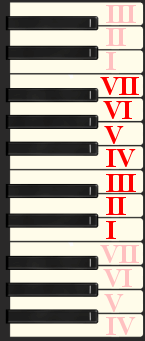
Key of C
Exactly as in: Three-chord rock and roll. (Those with a bit of musical theory background know them fondly as the I, IV, and V7 chords.)
Further, a musical chord requires at least three notes, and those required three define the root name and basic nature of the chord (for example, a C chord or an E chord).
Adding more notes makes the chord more interesting, but doesn’t change its root.
(Two notes just forms a musical interval.)
I’ll get more into this some other time. I’ve been thinking of digging out my old keyboard, seeing if it still works, seeing if I can still play, and seeing if I can record some samples of what I’d write about.
Seems like a post about music theory needs examples.
(But don’t hold your breath waiting for me to get around to it. I’m still working through a large backlog of notes and post ideas.)
∇













February 16th, 2016 at 4:55 am
So I am guessing a theory about numbers now. I guess that 1 is the most common number that we encounter – one sun, one Earth, one me, one you, etc. I guess that 2 is the next most common number, then 3, then 4, etc.There will no doubt be exceptions to this rule, but I’m guessing you won’t do a post about the number 594.
February 16th, 2016 at 9:53 am
Heh, well now I almost have to! 🙂
Obviously 594 is a multiple of 9 (because 5+9+4=18 and 1+8=9). It factors as 2×3×3×3×11 which, somewhat interestingly, is 2×33×11. It’s year 1 in the Bengali calendar. It’s a Harshad number…
OTOH, Wiki lumps it in with all number in the 500–599 range, so it doesn’t even have its own Wiki page, poor thing. 😮
So I think you’re quite right that lower numbers apply to more things. There is also the interesting phenomenon known as Benford’s law. For fun, I went and found four sets of numbers. One was populations of major cities, one (IIRC) was heights of mountains, I forget what the other two were.
I ran them through a simple Python program that generated a frequency count on the first digit, and my results fall within Benford’s law:
In a random set of numbers, they just don’t seem to start with 9 or 8 (or even 7) that often. Weird, eh? And check out this binning:
Half the digits in that set of number began with 1, 2, or 3. It’s even weirder considering this:
Over 25% of the numbers start with the digit 1!
And ya just gotta love Python. When I said “simple program,” I meant it!
def Benford (numbers): a = [0] * 9 for n in numbers: s = str(n) c = int(s[0]) a[c-1] += 1 return aSuch a sweet little language! XD
February 16th, 2016 at 10:31 am
Well, Wyrd, you have certainly uncovered a lot of interesting info here. I hadn’t heard of Benford’s law, but it seems to be showing what I guessed (at least up to the number 9) but to a much stronger degree than I ever imagined!
February 16th, 2016 at 10:50 am
Yeah, weird, isn’t it? And we don’t really know why it works like that. There are some ideas, but nothing definite.
Viewed as cardinalities, as you pointed out originally, there are lots and lots of things with a cardinality of one. As I’ve written about, pairs of things are also extremely common (cardinality: 2). This post, and the earlier one, speak about the prevalence of things with cardinality of three.
Each degree of cardinality results in fewer things that have that count. About the only thing with a cardinality of 594 is: “Number of years elapsed so far in the Bengali calendar.”
February 16th, 2016 at 1:45 pm
Isn’t Benford’s law true because of logarithmic growth? On a logarithmic scale, most things happen just after 1.
February 16th, 2016 at 3:10 pm
It definitely seems related to logarithms. I’ve always wondered if a related element is that zero is never a leading digit (or, conversely, is always the leading digit 🙂 ).
The thing is, where is the logarithmic growth in a set of numbers reflecting population sizes or area sizes of lakes or heights of mountains? It’s weird that such a set of (you’d think kind of random-ish) numbers is so clearly distributed that way.
February 17th, 2016 at 8:34 am
I think that logarithmic growth is very common. Population numbers are never going to be distributed uniformly – that would mean that there just as many cities as small towns. Instead, there are a few megacities, hundreds of cities, and probably millions of small villages and towns. Therefore population numbers follow a logarithmic distribution.
Similarly mountains – just one Everest, lots of hills, and uncountably many small mounds in the middle of people’s lawns.
February 17th, 2016 at 3:43 pm
“Therefore population numbers follow a logarithmic distribution.”
Sure, but this involves the leading digit of numbers. I can definitely see the distribution of any given set of natural constants falling that way, but their leading digits? What kind of distribution is that?
It implies that, in the range 1-99, and in the range 100-199, and in the range 1000-1999, and so forth, that the first part of that range has the most members. Seems like the distribution around 80-120 or 800-1200 would be fairly even. (But I’m not a mathematician.)
February 18th, 2016 at 6:32 am
The point is that the numbers are uniformly distributed on a logarithmic scale. Geometric growth leads to a log-normal distribution, whereas arithmetic growth results in a normal distribution around a mean. Thus Benford’s law applies only to scale-invariant processes.
The Wikipedia page gives the example of 1,000 bacteria growing exponentially, and doubling in number each day:
On the first day, the number of bacteria is increasing from 1000 towards 2000: The first digit is 1 the whole day. On the second day, there are 2000 bacteria increasing towards 4000: The first digit is 2 for fourteen hours and 3 for six hours. On the third day, there are 4000 bacteria increasing towards 8000: The first digit will pass through 4, 5, 6, and 7, spending less and less time in each digit. The next day, there are 8000 bacteria increasing towards 16,000. The leading digit will pass rapidly through 8 and 9 in a few hours, but then once there are 10,000 bacteria, the first digit will be 1 for a whole 24 hours, until the number of bacteria gets to 20,000. Therefore, the first digit is 1 with the highest probability, and 9 with the lowest.
February 18th, 2016 at 10:45 am
I’m still confused because there is no sense of “growth rate” with regard to the areas of lakes or the heights of mountains, and the Wiki page seems to indicate that such growth rates are just one example of a distribution that fits Benford’s law. I think maybe the more general view is expressed in a section below the one you quoted, the one labeled Scale invariance:
If you consider a random distribution across a logarithmic scale, such that the distribution looks linear on that log scale, then more points will fall in the “1” bins (“1”, “10”, “100”, etc) simply because they are the largest bins. The “2” bins are next largest, and so forth.
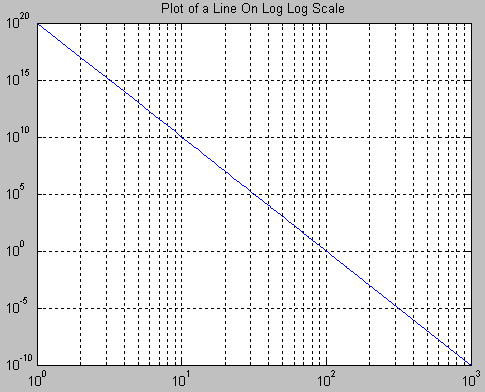
But this seems to still beg the question of why unrelated mountain heights (or lake areas) would distribute in apparently linear fashion when plotted on a log scale.
February 18th, 2016 at 11:56 am
Because everything in the world is either linear or exponential 🙂
February 18th, 2016 at 12:10 pm
Okay, then.
February 16th, 2016 at 1:23 pm
I find myself using triples when writing. As in I did something, and something else, and then a 3rd thing thrown in for humor or effect. And sometimes I use the oxford comma, sometimes I don’t.
February 16th, 2016 at 3:05 pm
Yep, the comic third item is a lot of fun. In the science fiction world, the third item is often the science fiction-y one. For instance, a character might refer to Earth’s greatest presidents: Washington, Lincoln, and Beeblebrox (the alien from Valarius, but she was born in the USA).
After a long debate with another blogger about the Oxford comma, he convinced me to start using it (way) more often than not. It’s actually gotten to (almost) be habit now.
February 20th, 2016 at 9:27 am
“I’ve been thinking of digging out my old keyboard, seeing if it still works, seeing if I can still play, and seeing if I can record some samples of what I’d write about.”
DO IT! 🙂
And yes, music theory would need some examples, at least for me. Even though I play guitar, I have no idea what I’m doing. I’d love to see you do some music theory posts.
February 20th, 2016 at 9:45 am
I don’t know how helpful they’ll be; it’s been a long time since I played or was into that stuff. But lately I’ve been thinking more and more about seeing what I still have left there.
Music is pretty interesting mathematically. Its one of those places where math and beauty combine. Its also a place that reveals how mathematical sensibilities seem intrinsic to us. We like mathematically “simple” melodies and (especially) chords.
My mind was blown way back in college when I hooked my synthesizer up to my oscilloscope such that I could compare two notes by seeing their Lissajous pattern. It turned out that the note intervals that were “simple” and most pleasing to the ear (such as the octave or the fifth) generated the simplest Lissajous pattern.
February 22nd, 2016 at 9:52 am
That’s interesting about the Lissajous pattern. I’d never heard of that.
I tend to like harmonious music (as opposed to anything atonal). I wonder if there’s some connection here to my preference for open tunings on my guitar? I love the way a chord played on an open tuning rings out. You can play the same thing in standard tuning (usually it’s harder, though, if the song was originally played in open) and it doesn’t sound as good.
February 23rd, 2016 at 9:36 am
“I wonder if there’s some connection here to my preference for open tunings on my guitar?”
Very possibly. An open tuning on a guitar allows the just intonation that gets away from the slight dissonance of the equal temperament. For example, if you tune for “Open D,” then the F# for the major third can be tuned precisely. In an equal temperament, it would be slightly off. (The equal temperament major third is a tiny bit sharp; the minor third is a tiny bit flat.)
Those with good ears can hear the dissonance of equal temperament, the beat notes that form! And if you don’t enjoy atonal music, or music done on quite different scales than Western music, I can well imagine you’d go for open tuning on your guitar!
There are even songs written for various guitar tunings!
The thing about the standard tuning (essentially fourths) is that it puts the strings close enough together that a variety of chords from different keys are relatively easy. Alternative tunings can be great for certain keys, but much harder for others. Lead guitar can also be a tiny bit harder due the the greater distance. You have to move up and down the fretboard more.
February 24th, 2016 at 12:18 pm
Very interesting. I do find it easier to tune my guitar to an open tuning. I can feel when everything’s perfect with an open tuning, the vibration of the guitar on my belly feels stronger. Weird, I know. It sounds so amazing when every string is perfectly tuned. In standard I’m constantly second guessing the tuning and tweaking. (I rarely use a tuner except to get one string to standard, and even then I usually prefer to just find a song I know and use that. It’s just the way I did it when I first started learning and couldn’t afford a tuner.)
When I hear others playing, I often want to say, “Your D string’s a bit flat.” But when I’m playing, and after tweaking the tuning for a while, I start getting tone deaf. It drives me bonkers. Sometimes I just have to put the guitar down and do something else to reset my ears. I don’t know if this has anything to do with what your calling “dissonance of the equal temperament” or if I’m just nutty. Probably the latter.
Funny, I do gravitate toward songs with an open tuning. Joni Mitchell, certain acoustic Led Zeppelin tunes (like “White Summer Black Mountainside”):
February 24th, 2016 at 2:59 pm
It sounds very much like you might have perfect — or at least very strong pitch. Can you identify a note you hear?
[I dated someone once (one of the better ones, wish it had worked out) who had perfect pitch. We’d be walking down the street and she’d point out a nearby motor hum or some other source of a steady tone and ask me what note it was. She, of course, always knew. For fun, I did test her a few times. She always got it right.]
If you can tell someone’s D-string is flat, that sounds very much like perfect pitch to me.
Many of our senses fatigue after constant exposure. In some cases they even counter-balance what they’re exposed to. I have a clock that sits below my TV. The clock has fairly large, very blue numbers. If I stare at it for a bit and then look away, I can see a yellow (the color opposite of blue) after-image of the numbers. 🙂
Smell the same smell for a while, and you can’t smell it anymore. Even sounds can fade into the background.
February 25th, 2016 at 8:55 am
Naw, I don’t think I have perfect or near perfect pitch. In the case of telling you whether a car honk is an F sharp, I couldn’t do it. I can hear whether something is out of tune on a guitar only because I’ve played it for so long.
Besides, I can’t read music really, so identifying a note would be pretty hard! I don’t know the notes on the guitar, except open strings in standard. (And I actually forgot those…EAD blank blank E. I can’t believe I can’t recall those!) You might wonder how I can tune my guitar to open tunings, but that’s just a matter of comparing one string to another. So I can tune the two Es to D, and the rest I tune down to “that thing that sounds right for that song I’m playing.” This is how rudimentary my guitar knowledge is. I “know” some complicated chords, but not by name. Only by some weird association in my head: “That one looks like a backwards D chord with a barre chord and it moves around the neck.” Sometimes I name them in my mind as “the such-and-such song chord.” You should see my friend who studied music theory try to teach me something on the guitar:
“It’s the blah chord.”
“I have no idea what you’re talking about.”
“Blah—music—blah—theory—blah.”
“Still no clue.”
“The Led Zep chord that’s in ‘Over the Hills and Far Away,’ except over here and with this added to it.”
“OH!”
So that’s how I learn a new chord. I either have tabs, or I make a comparison to a chord I know. I never learn the name of the chord. The only chord names I know are the really basic ones.
I can sort of fake my way through sheet music on a piano, but not at all on guitar. I once tried to learn a Chopin nocturne by going through “Every Good Boy Does Fine” etc. That was a pretty slow process. I eventually had to listen to the CD to check myself. Then there was a double sharp, which blew my mind and sort of pissed me off. My friend explained that it would make sense if I knew music theory. I thought it was just incredibly annoying.
February 25th, 2016 at 11:23 am
“I can hear whether something is out of tune on a guitar only because I’ve played it for so long.”
Well, at the very least you must have very good pitch discrimination. It’s possible that if you knew your way around a musical score more you would be able to identify the note of some random tone. (Car horn honks might be too made up of multiple frequencies to have a specific pitch, also their short duration makes it hard to assign a specific pitch.)
The way you describe guitar chords,… are you generally more in tune with shapes and images than words and numbers? (I know you’re not big on math.) You may be more visually oriented than text oriented.
Just last night I was playing around a little, brushing up on my basic music theory. Maybe I’ll do a very basic post about that soon. Chord basics are actually pretty simple if approached right. Anyone ever do the 12-hour clock thing with you?
An interesting coincidence (?) there… 12 hours in a day; 12 notes in a (Western) scale. As such, we can use a clock to illustrate a lot of basic points about scales, intervals, and chords.
(And I actually forgot those…EAD blank blank E. I can’t believe I can’t recall those!)
E-A-D-G-B-E 🙂
I’d say the first five are all fourth intervals, but that probably isn’t helpful. Those intervals are why one can tune a guitar by comparing the harmonics of two strings.
Of course, those with very good pitch discrimination do it by ear! XD
“Then there was a double sharp, which blew my mind and sort of pissed me off.”
Heh! I know it seems excessive, but your friend was right. It does make sense. 🙂
February 25th, 2016 at 12:05 pm
“Are you generally more in tune with shapes and images than words and numbers?”
I’m definitely a word girl. Just not math. 🙂 Tabs are numbers, but they’re easy to read since they’re shaped the same way a guitar is. There are a few little things you have to pay attention to: slides, hammer-ons and offs, harmonics, etc., but it’s fairly straightforward.
“Just last night I was playing around a little, brushing up on my basic music theory. Maybe I’ll do a very basic post about that soon.”
You should!
“Anyone ever do the 12-hour clock thing with you?”
Nope. Never heard of it. I never took guitar lessons, though. However I did take piano lessons when I was very young. Also the mandatory music classes in elementary school.
“I’d say the first five are all fourth intervals, but that probably isn’t helpful. Those intervals are why one can tune a guitar by comparing the harmonics of two strings.”
Yeah, I don’t know anything about intervals. Seriously, it’s “Every Good Boy Does Fine.” Sharps and flats on the most basic level. That’s it.
Oh I believe the double sharp makes sense in some way, I just didn’t find it helpful. 🙂
February 25th, 2016 at 12:26 pm
“Tabs are numbers, but they’re easy to read since they’re shaped the same way a guitar is.”
That shape is what makes them images to me!
The 12-hour clock thing is music theory, not guitar specifically. I didn’t run into it myself until recently, so it might be a new approach, perhaps due to people using math more to analyze music.
I added a new comment down below… a table that shows a rough sketch of what I was doodling with last night. See that comment for explanation. (I wasn’t sure a table would post as a comment, but it did.)
“Yeah, I don’t know anything about intervals.”
An interval is the distance between two notes, either played simultaneously or one after the other. That distance can be expressed in semi-tones or steps of the scale of the key. Semi-tones are the adjacent notes of the piano (using all the keys) or adjacent frets on a fretboard.
But more typically they’re expressed in terms of the scale distance. On a piano, for example, the white keys comprise the scale of the key of C. If you find C on the piano and just play the white keys going up, you play the famous “Do, Re, Mi, Fa, Sol, La, Ti, (and back to) Do.”
From do to re is a second, from do to mi a third, from do to fa a fourth, from do to sol a fifth, from do to la a sixth, from do to ti a (major) seventh, and from do to do an eighth or octave.
The interval between the first five guitar strings (a fourth) is the one from do to fa.
Your basic major chord, a C chord or a G chord, consists of do-mi-sol; a third plus a fifth. Power chords drop that middle third (the mi) because intervals of fifths sound amazingly “pure” and harmonious, and when you amplify the livin’ shit out of them the intermodulation harmonics turn power chords into something pretty, well, powerful.
Anyway, see the table below for a bit more music theory… XD
February 26th, 2016 at 9:32 am
Now I get it! You should teach music. Explaining it in terms of the fretboard and piano makes a lot more sense.
I didn’t get the table, though…unless I’m missing something?
February 26th, 2016 at 3:48 pm
Thanks, that’s nice to hear. (I’ve had reason in the last decade or so to doubt my teaching skills. I tend to include too many details!)
The piano keyboard makes a good foundation I think because of how it lays out the notes, all of them, left-to-right. Makes it easy to see the relationships between notes. It’s very easy to relate the piano keyboard to the musical staves; you can literally overlay the latter on the former.
The table is my best way of presenting a “clock” in a comment. The idea is that you can rotate the notes column so that any note is at the top, which changes the key from C to whatever note you pick. Then the three right columns show the three basic chords in that key.
It also illustrates how each of those three chords is really the same chord rotated around the clock. The interval between the “1” (do) and “3” (mi) note is always constant and so is the interval between the “3” and “5” (sol) note.
In fact, it’s those intervals that define those chords as major chords. The “1” (do) note gives them their first name (in the key of C, it’s C, F, and G) and the intervals that give them their “family” name — in this case “major” – C-major, F-major, G-major. Since these are the base chords, we usually leave the “major” off unless it’s necessary to disambiguate a reference.
(If that middle note, the “3” (mi), is lowered a half-step, making the 1-3 interval a half-step less and the 3-5 interval a half-step bigger, the chord’s family name is “minor” — C-minor, F-minor, G-minor.)
((The G7 takes a bit more explaining, but adding that 7 note gives the chord a stronger feeling of needing resolution to the root C chord than just a G chord does. But the G7 formed here is different from the F7 or C7 that would be likewise formed using the “white keys only” rule of the key of C. For one thing those two are called F-maj7 and C-maj7 (or F-M7 and C-M7), which are whole other chords than the G7! Which is technically a G+minor7, which is not at all the same as a G-minor+7. The former has a minor (flatted) seventh (‘ti’), the latter a minor third (‘mi’). Like I said… more involved. 🙂 ))
February 29th, 2016 at 8:56 am
Yeah, I’m lost on the G7 part. 🙂
Those are the chords I probably know, but don’t know that I know unless I’m looking at tabs. Then I say, “Oh! That one shaped like…”
February 29th, 2016 at 9:41 am
Then maybe this will help:

It’s from a website you might like (where you can select any chord and get the tablature for it): http://www.all-guitar-chords.com/
If that top string on the G7 (which is currently fretting the [1] is moved down the neck to the [3] position you have the plain old G chord.
February 29th, 2016 at 9:56 am
Cool! Thanks. Funny, I always play “G” with E and B fretted on the 3rd. That open B sting bothers me there.
February 29th, 2016 at 10:03 am
Might be your sensitivity to equal temperament tuning there. By raising the open B to a D you’re making more of a power chord — except for that A string fretted to a B. A normal G chord (in first position) plays G-B-D-G-B-G, but if you fret the B to a D, you’re playing G-B-D-G-D-G.
February 25th, 2016 at 12:08 pm
February 25th, 2016 at 12:34 pm
Okay, so try to translate the above table to a 12-hour clock. The hour column is the same as the numbers on the clock except that 12 is shown as 0 (recall that a term for midnight is “zero-hundred hours”).
The note assigns notes to the clock. In this case C is assigned to high noon, but the notes can be rotated such that any desired note is at the high noon position. Doing such a rotation changes the key. Putting C at the top causes the clock to be about the key of C.
The key column picks out the notes of the C major scale, the “key of C.” A Western major scale has seven notes (do, re, mi, fa, sol, la, ti) indicated here as I, II, III, etc.
The I (C), IV (F), and V7 (G7), columns show the primary three chords for a given key. The numbers are the intervals from the chord’s root (the 1).
The chords are named after their root, either by the roman numeral (which makes them key-free) or by the note itself (e.g. “C”). All keys have a I, IV, and V (or V7) chord. In the key of C, those are also C, F, and G7.
The “7” is because we often add the seventh interval to the V chord to give it a hanging dissonance that demands resolution into the I chord.
(There is a story that Mozart’s man servant would wake his master by playing a V7 chord (like G7) on the piano. Which really leaves one hanging. After a bit, the servant would hear the pitter patter of feet towards the piano and then a resounding I chord (like C) would ring out.)
((There is a Beatles tune that ends on a V7 chord… it really is kinda jarring. 🙂 ))
February 25th, 2016 at 12:53 pm
The key to the whole thing is the intervals between notes of the scale and between notes of the chords.
Note how the key of C uses the clock numbers: 0, 2, 4, 5, 7, 9, 11. Most scale intervals are two semi-tones (“hours” of the clock), but the jump from 4 to 5 is just one. So is the jump from 11 back to 0.
So a major scale has the semi-tone steps: 2, 2, 1, 2, 2, 2, 1. That set of steps is what defines a major scale.
Major chords (such as all three shown) have the semi-tone steps: 4, 3. (Minor chords are 3, 4.)
Chords look like an arrangement of three (or more) clock hands pointing to the chord notes. The type of chord is defined by the steps between notes. The name of the chord is based on its root note.
Merely rotating an arrangement of hands transposes a given chord to a new root note. Rotating a C chord gives you the F and G chords.
Musically, C, F, and G, are related not just because they’re in the same key, but because they share some notes.
June 23rd, 2021 at 9:49 am
[…] came the sequel, Three-peat., which explored the world of triples in more detail. That world spans the gamut from witches to […]
June 4th, 2024 at 5:46 pm
[…] like Yin-Yang or Rule of 3 — just a lens through which to […]